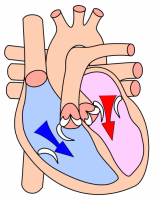Diastole
part of the cardiac cycle when the heart refills with blood following systole (contraction) From Wikipedia, the free encyclopedia
Remove ads
Diastole (pronounced /daɪˈæstəliː/) is the time during a heart beat when the heart fills with blood after a contraction. The contraction of the heart is called systole and is the opposite of diastole. The term diastole comes from the Greek word διαστολη. This means expanding or opening.[1]

Inside the heart
There are two types of diastole.
- Ventricular diastole is the time when the two lower chambers of the heart called the ventricles are relaxing to let the blood to flow in.
- Atrial diastole is the time when the two upper chambers of the heart called the atria are relaxing to allow the blood to flow in.
During ventricular diastole, the pressure in the (left and right) ventricles drops. When the pressure in the left ventricle becomes lower than the pressure in the left atrium, the mitral valve opens. The blood then flows from the atrium into the ventricle. The speed at which the blood flows into the ventricles can be used to diagnose diastolic dysfunction.[2]
Remove ads
Diastolic pressure
Because the heart relaxes during diastole, "diastolic pressure" is the lowest pressure within the arterial blood stream during each heart beat. The highest arterial pressure happens when the heart muscle contracts, and is called systolic pressure.
When blood pressure is measured for medical purposes, diastolic pressure is the second number in the "ratio" of systolic to diastolic pressure; for example: 120/80.
Remove ads
Related pages
- Systole (medicine)
- Blood pressure
- Wiggers diagram
References
Other websites
Wikiwand - on
Seamless Wikipedia browsing. On steroids.
Remove ads
